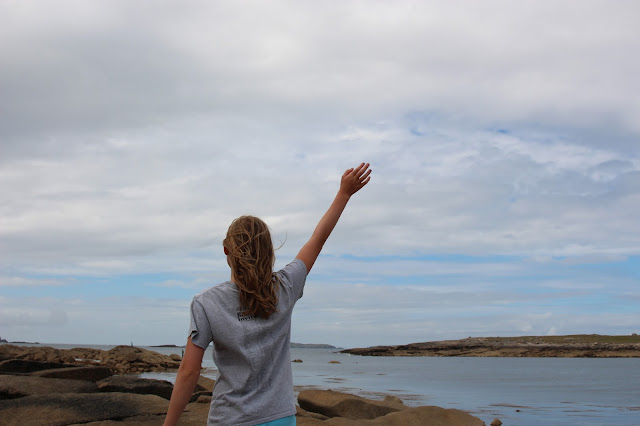 |
| A sure sign of autumn here at the West Coast: Crocosmia |
 |
| The orange flower pedals remind me of the beak and paddles of Suzy Goose! |
 |
| This book contains lots of action words for you to try! |
Der Herbst macht sich erkenntlich an den Farben Gelb, Orange und
Braun. Gelbe und braune Blätter finden sich an den (wenigen) Bäumen hier
reichlich. Allerdings kann man vergeblich auf Orange warten, das einfach keine
Lust hat, so hoch oben die Baumkronen zu färben. Dafür zeigt es sich rotzfrech
am Wegesrand.
Wenn dort Crocosmia sich in all ihrer Pracht reckt und streckt,
ist es allen klar: Der Herbst ist da, sogar schon seit August. (Die
Jahreszeiten haben es in Irland etwas eiliger. Offiziell ist November schon
Winteranfang!
Crocosmia, oder auch Montbrecia genannt, ist
keine einheimische Pflanze, sondern zugewandert, wie so viele Menschen hier auch. Und mit ihren leuchtenden orange farbigen Blüten fügt sie sich wunderbar in die irische Landschaft ein.
Es lässt sich durchaus sagen, dass ohne sie das Leben (oder besser der Herbst)
viel blasser wäre.
Ihre schmalen orangenen Blütenblätter erinnern mich zudem
an die Schnäbel und Paddel der Gänse in dem von Petr Horácek illustrierten Pop
Up Buch "Silly Suzy Goose". Der in England lebende Tscheche wurde
schon zahlreich ausgezeichnet für seine wunderbaren Kinderbücher. Auf seinem Blog lässt sich viel staunen und freuen.
Horáceks Buch "Silly Suzy Goose" eignet sich hervorragend für kleine
Bewegungseinheiten, denn Suzy, die Gans ist abenteuerlustig!
So begibt sie sich auf Wanderschaft durch die Tierwelt und stellt
fest, dass sie gerne so springen möchte wie ein Kangaroo, sich so lang
strecken wie ein Giraffenhals oder mit den Flügeln schlagen wie eine
Fledermaus.
Das Bilderbuch ist also voll mit Bewegungswörtern, die Kinder
anregen können, es den Tieren gleich zu tun:
Fragt doch mal:
“Kannst du GLEITEN auf dem Eis wie der
Pinguin, so hoch SPRINGEN wie das Kangaroo, mit den Flügeln schlagen wie die Fledermaus etc.? Könnt Ihr mir es zeigen?”
Und wer kann am Ende der Geschichte am besten “Rooarrhonk” sagen,
abgesehen von Suzy Goose natürlich?
Es gibt viel zu entdecken in diesem kleinen Büchlein. Auch wer
sich lieber auf dem Sofa lümmelt wird viel Spaß mit dieser verrückten Gans und
den herrlichen Illustrationen haben.
Autumn colours are yellow, orange and brown. You will find lots of
yellow and brown leaves on the trees here (apart from the fact there are not
many trees in Connemara).
Orange,however, is hardly visible in the crowns of the trees. It seems too
lazy to dye the crowns, but instead shows off at the roadsides.
When Crocosmia, also called Montbretia, is in blossom, everyone knows that autumn is here
(and already since August! Seasons start much earlier here in Ireland).
Although Crocosmia grows abundantly in the Ireland, it is
originally a native to the grassland of southern and eastern Africa. However,
it beautifully complements the colours of autumn here at the West
Coast.
And without Falling Stars, as the plant is called in America, this
season would be much plainer and my mantle piece as well that surely lacks some
brightness as well!
The plant’s narrow and very bright orange flower petals remind me
as well of the geese beaks and paddles in the book “Silly Suzy Goose”. This pop-up book is illustrated and written by Petr Horácek. He was born in former Czechoslovakia, and now lives in England with his wife Claire and his two
daughters. He has received numerous awards for his books and especially for "Silly Suzy Goose".
Suzy is a very adventurous little goose. She likes to be different
from all the geese around her. Therefore she studies lots of other animals and
their ways to move. She wants to SWIM like a seal, RUN like an ostrich or ROAR
like a lion that finally causes big trouble for the little goose.
This little POP-UP book is full of actions words that will invite
children to move like the animals Suzy meets in the story.
ASK the Children:
Can you GLIDE like the penguin, FLAP your wings like the bat, JUMP
like a kangaroo or stretch your NECK as long as the giraffe?
And who is able to say “Rooarrhonk” apart from Suzy of course?
That will cause lots of giggles if you give it a serious try yourself!
There is a lot to explore in this little book. However, if you
prefer just to read the story without any movement exploration, you will still
have lots of fun with this silly Suzy goose and Petr’s admirable
illustrations.






















































